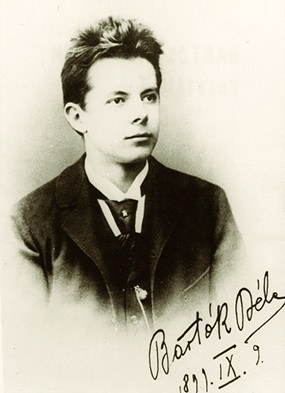Now I’ll be the first to admit that I’m not much good at dancing. Not much good at all. To be honest, I am completely useless at dancing and would have a better chance of parsing Sanskrit rather than doing the waltz.
I blame my old secondary school. Oh yes, they used to teach us how to dance, especially before the Christmas social evenings but because the medieval gramophone rarely worked, I got the job of playing the piano, being the only one in the class who could make a decent job of it. So while the other spotty teens were stumbling about in the school hall learning all the steps, I was stuck at the piano. On reflection, it probably didn’t matter very much because not many people these days do the waltz, let alone the Boston Two Step.
 Bartók’s high-school-graduation photo, 1899.
Bartók’s high-school-graduation photo, 1899.
Perhaps the human body was meant for dancing, except mine of course. Dance has been part of ceremony, ritual and celebration for thousands of years. Archaeologists have traced dance back to around 3,000 BC and its origins may be even earlier. I wouldn’t mind betting that some of the earliest forms of dance, especially those for ceremonial or religious purposes might have existed without any kind of musical assistance.
In more modern times, the concept of dance without music is difficult to imagine and for the last couple of millennia music and dance have become inextricably linked. Since Baroque times, composers have turned to dance music for ideas and inspiration. Dance suites have been popular since the early seventeenth century and remained popular with composers ever since.
Béla Bartók (1881-1945): Dance Suite. Deutsches Symphonie-Orchester Berlin, cond. Ingo Metzmacher (Duration: 16:22; Video: 720p HD)
Hungarian tourist guides are fond of telling everyone that their capital city was once made up of two separate towns. Buda is the old aristocratic town on the hill overlooking the Danube and Pest lies on the flat land on the opposite side of the river. The two towns were officially merged in 1873 and with a flash of original thinking were re-named Budapest.
In 1923, the city council threw an enormous party to celebrate the fiftieth anniversary of the merger. To bring a sense of gravitas to the event, the council decided to stage a grand concert for which the country’s leading composers were commissioned to contribute new works. One of them was Béla Bartók, who composed the Dance Suite for the occasion. He was extremely unhappy about the performance and afterwards wrote that “it was so badly performed that it couldn’t achieve any significant success. As usual, rehearsal time was much too short, so the performance sounded like a sight-reading, and a poor one at that.”
Bartók had to wait another two years until the work got the performance it deserved – in Prague, as it turned out. The work was rapturously received and during the following years it was played all over Europe. It probably did more for Bartók’s reputation than all his previous works put together.
Bartók had been studying and recording folk music since 1905 and although the melodies in the Dance Suite speak of Eastern Europe they are entirely Bartók’s own invention. The work is full of typical Hungarian rhythms and along with his popular Concerto for Orchestra, it makes an excellent introduction to the music of this titan of the twentieth century.
The Deutsches Symphonie-Orchester Berlin was founded in 1946 by American occupation forces and called the RIAS-Symphonie-Orchester. The acronym stands for Rundfunk im amerikanischen Sektor and in1956 it was renamed the Berlin Radio Symphony Orchestra and in 1993 assumed its present name. The Orchestra’s first principal conductor was Ferenc Fricsay whose distinguished son lives in Pattaya.
Leonard Bernstein (1918-1990): Symphonic Dances from “West Side Story”. Simón Bolívar Youth Orchestra of Venezuela cond. Gustavo Dudamel (Duration: 23:04; Video: 480p)
West Side Story was inspired partly by Shakespeare’s Romeo and Juliet. The story is set in New York City in the mid-1950s and explores the rivalry between the Jets and the Sharks, two teenage street gangs of different ethnic backgrounds. Dance plays a crucial role in the musical and it contains some wonderful melodies presented with brilliant orchestration.
Contrary to popular belief, the Symphonic Dances were not actually orchestrated by the composer although he closely supervised the process. He wrote the score of the original stage production, but later appointed several people, among them the professional orchestrators Irwin Kostal and Sid Ramin to scale up the music from a theatre band to a huge symphony orchestra.
Vibrant instrumental combinations and a huge percussion section are used to enhance the music. It is truly exciting stuff and it includes all the well-known numbers from the show. If you have fond memories of West Side Story, I am sure you’ll enjoy this version played by this superb orchestra.




